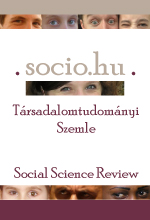Etnikai besorolási gyakorlatok. A cigányság külső kategorizálását befolyásoló tényezők
Contributions to the background of external categorization of Roma
Author(s): Patrik Tátrai, Ágnes Palóczi, István Zoltán Pásztor, János PénzesSubject(s): Social Sciences, Sociology, Methodology and research technology, Demography and human biology, Ethnic Minorities Studies
Published by: MTA TK Szociológiai Intézet
Keywords: ethnic categorization; Roma; classificatory systems; ethnicity
Summary/Abstract: Research regarding the number of Roma has been of significant interest in Hungary for a long time, however the results of such research (i.e. figures for the number of Roma) largely deviate from each other. However, this deviation does not necessarily mean a “measurement error”, rather it reflects the different approaches and methods between surveys. The present paper is an attempt to compare surveys and spatial databases concerning the peculiarities of the Roma population in Hungary, to present the main differences between classificatory systems and to explain the factors behind them. This analysis is partly based on the authors’ data collection. In addition to providing an overview of previous surveys, this study aims to compare (1) self and external ethnic identification at national level and (2) different types of external categorizations using Szabolcs-Szatmár-Bereg County as an example. Results show that the interconnection between external and internal assessments is influenced by the size of settlement, local proportion of Roma, and socio-economic characteristics like educational attainment, economic activity and income. Although the outcomes of surveys applying external classification vary widely, they follow more general demographic trends among Roma in the long term. Overall, by comparing different types of approaches, the present study argues that the boundaries of Roma ethnicity are blurred, external categorization is based on incoherent criteria and the operating mechanism of ethnic identification/classification forms a very complex and ever-changing system.
Journal: Socio.hu Társadalomtudományi Szemle
- Issue Year: 7/2017
- Issue No: 2
- Page Range: 1-21
- Page Count: 21
- Language: Hungarian

